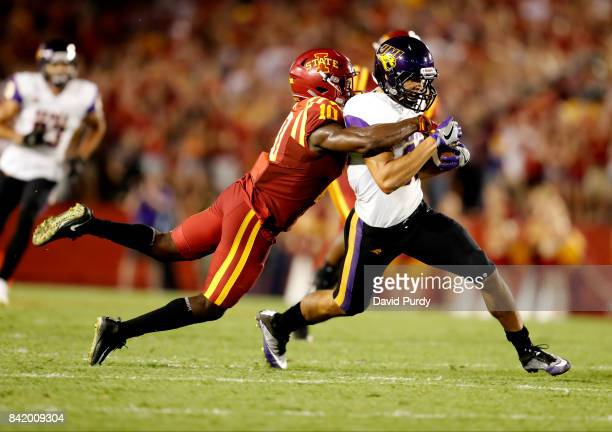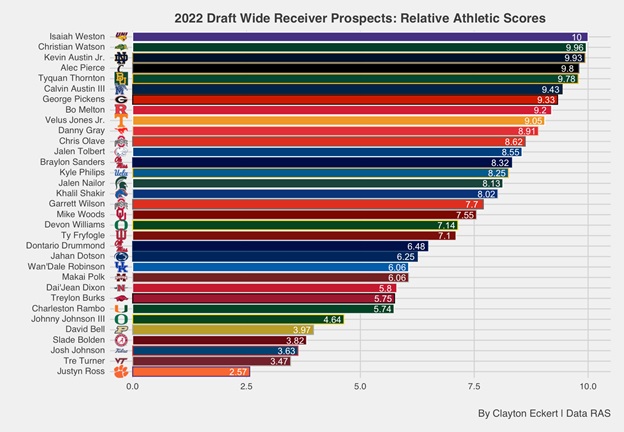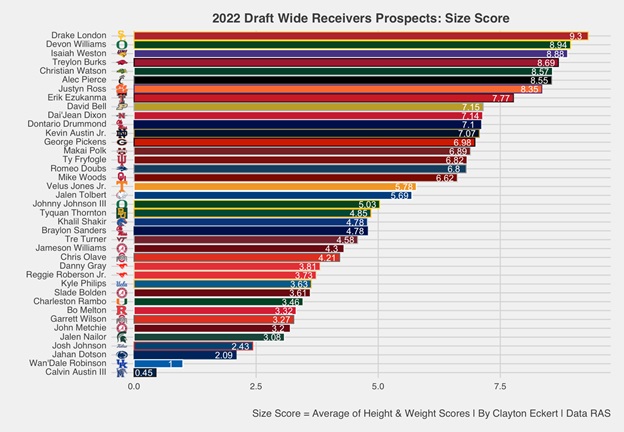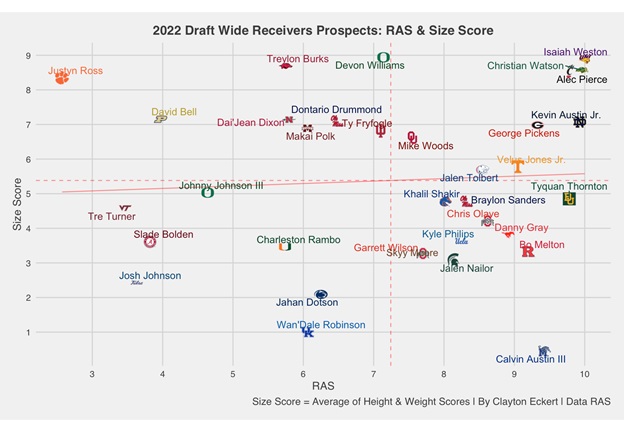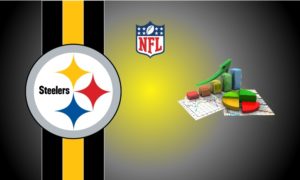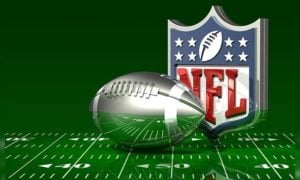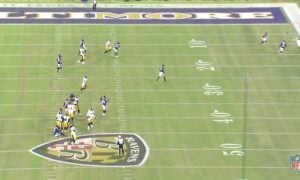Today I wanted to visualize some great data from Kent Lee Platt’s Relative Athletic Scores (RAS) for the wide receivers. Here is a link to his website in case you haven’t seen his work https://ras.football/. To qualify for a RAS score, a player must have a total of six recorded metrics from any of the following: Height, Weight, Forty-yard dash, Twenty-yard split, Ten-yard split, Bench Press, Vertical Jump, Broad Jump, Short Shuttle, and 3-Cone. The player is then graded on each in comparison to the positional database since 1987 to get more of a feel of their size, speed, explosion, agility, and total value, giving context to the raw numbers.
The goal of the series is to provide the RAS from Platt, with a bit of my own twist with a size score and visualize it to get a simultaneous view of all the players at their position that participated at the combine. Here are the players that qualified (NOTE: Positions are grouped from the combine results tracker compiled by Dave Bryan and Alex Kozora):
Nine of the 34 qualifying players have a RAS above nine, starting with Northern Iowa wide receiver Isaiah Weston who has a perfect 10 score with elite speed and explosion, along with great size! North Dakota State wide receiver Christian Watson also has elite speed and explosion with great size and good agility. Notre Dame wide receiver Kevin Austin has elite speed and explosion, great agility, and good size. Cincinnati wide receiver Alec Pierce has elite speed and explosion, great size, but poor agility. Baylor wide receiver Tyquan Thornton has elite speed, great explosion, and okay size. Continuing with RAS’s below 9.5, we see Memphis wide receiver Calvin Austin III who has elite speed, explosion, and agility but very poor size. Georgia wide receiver George Pickens has great speed along with good size and explosion. Rutgers wide receiver Bo Melton has elite speed, good explosion and agility, but poor size. The final player with an above nine score is Tennessee wide receiver Velus Jones Jr. who has elite speed and okay size and explosion.
Seven players have a RAS above eight, and SMU wide receiver Danny Gray topping that group with elite speed, good explosion, but poor size. Ohio State wide receiver Chris Olave has elite speed, okay explosion, but poor size. South Alabama wide receiver Jalen Tolbert has great speed, good explosion, and okay size and agility. Ole Miss wide receiver Braylon Sanders has great speed, good agility, with okay size and explosion. UCLA wide receiver Kyle Philips has elite agility, good speed and explosion, but poor size. Michigan State wide receiver Jalen Nailor has elite explosion, great speed, okay agility, but poor size. Boise State wide receiver Khalil Shakir has elite speed, good explosion, okay size, but poor agility.
The following players have a RAS above seven, beginning with Ohio State wide receiver Garrett Wilson who has elite speed, good explosion, but poor size. Oklahoma wide receiver Mike Woods has great speed, good size and explosion, but poor agility. Western Michigan wide receiver Skyy Moore has elite speed, good explosion, but poor size and agility. Oregon wide receiver Devon Williams has great size, good explosion, but poor speed. Indiana wide receiver Ty Fryfogle has elite explosion, good size and speed, but very poor agility.
After a noticeable drop off, four players have a RAS above six. Ole Miss wide receiver Dontario Drummond has good size, okay speed and explosion, but poor agility. Penn State wide receiver Jahan Dotson has great speed, good explosion, but very poor size. Kentucky wide receiver Wan’Dale Robinson has elite speed, okay explosion, but very poor size. Mississippi wide receiver Makai Polk has good size and speed but poor explosion and agility.
The next three players are the last men with RAS’s above five for 28 total, a great percentage of 82.4 on the plot with above average scores! Nicholls State wide receiver Dai’Jean Dixon has good size, speed, and explosion but very poor agility. Arkansas wide receiver Treylon Burks has great size, good speed, okay explosion, but very poor agility. Miami wide receiver Charleston Rambo has good speed, but poor size and explosion.
After a big drop off, six players have below five RAS scores. Oregon wide receiver Johnny Johnson III has good speed, okay size, but poor explosion and very poor agility. Purdue wide receiver David Bell has good size, okay speed, but poor explosion and very poor agility. Alabama wide receiver Slade Bolden has good speed, but poor size and explosion. Tulsa wide receiver Josh Johnson has okay speed but very poor size. Virginia Tech wide receiver Tre Turner has great speed, okay size, but very poor explosion and agility. The final player is Clemson wide receiver Justyn Ross who has great size but poor explosion and very poor speed with the lowest RAS of 2.57!
Next, I wanted to provide context with a size score using the RAS for the players height and weight, which includes all the combine invites since all the players are measured:
Here we see exactly 50% of the combine invites have above five size scores, highlighting the athletic but smaller overall class compared to the historical data. USC wide receiver Drake London is the only player with an above nine size score but did not test otherwise.
Six players have a size score above eight, starting with Devon Williams from Oregon who also has a +7 RAS. Weston topped the RAS plot and is ranked third in size score! Burks fares well here but important to remember his lower but above five RAS. Watson has the second-best RAS along with the fifth ranked size score! Pierce has similar value the sixth ranked size score paired with the fourth best RAS! Ross is the final player in this size group, but crucial to remember he has the worst RAS result.
Texas Tech wide receiver Erik Ezukanma leads the group of players with above seven size scores but didn’t qualify for an RAS, testing minimally with great explosion and good size. After a drop off, Bell has good size but important to remember his below average and fifth lowest RAS. Dixon has good size to pair with his +5 RAS, but important to remember his very poor agility. Drummond is similar with slightly better agility. Austin Jr. is the final player of this group with great value at his size considering his third ranked RAS in the high nines!
The following players have above six size scores. Pickens tops this group, along with his +9 RAS! Polk has a better size than RAS score, both in the plus six range. Fryfogle just eclipsed a seven RAS to pair with his upper six size score. Nevada wide receiver Romeo Doubs has good size, but unfortunately didn’t test otherwise. Woods fared better athletically with a mid-seven RAS at his size.
The final three players I will point out here cap off the above five size scores. Jones Jr. pairs his okay size with a strong +9 RAS! Tolbert has a mid-eight RAS at his size, and Johnson III barely peaks the above five size number, unlike his RAS of 4.64.
To wrap up, here is a visual layering the RAS and size score:
The graph highlights Weston, Watson, and Pierce as the players with the best package of size and athleticism of the qualifying players. Austin Jr. matches them in athleticism, and the other players above the mean in both data points include Pickens, Jones Jr., Tolbert, and Woods. Several players on the bottom right provide great value as well with above average athleticism needed at the position, along with the top left group all around +7 scores or above. One thing’s for sure, it is a strong class with depth that provides many versatile options for teams to take advantage of.
For those that like the numbers, it’s unfortunate a few players (mainly London, Doubs, and Ezukanma) didn’t test fully, especially considering the need at the position. It will be interesting to monitor the pro days and continue to see how the men stack up in the coming weeks when Platt updates the site with the unofficial numbers.
What are your thoughts on the data? Thanks for reading and let me know your thoughts in the comments!

